battery MITSUBISHI iMiEV 2014 1.G Owners Handbook
[x] Cancel search | Manufacturer: MITSUBISHI, Model Year: 2014, Model line: iMiEV, Model: MITSUBISHI iMiEV 2014 1.GPages: 16, PDF Size: 2.49 MB
Page 4 of 16
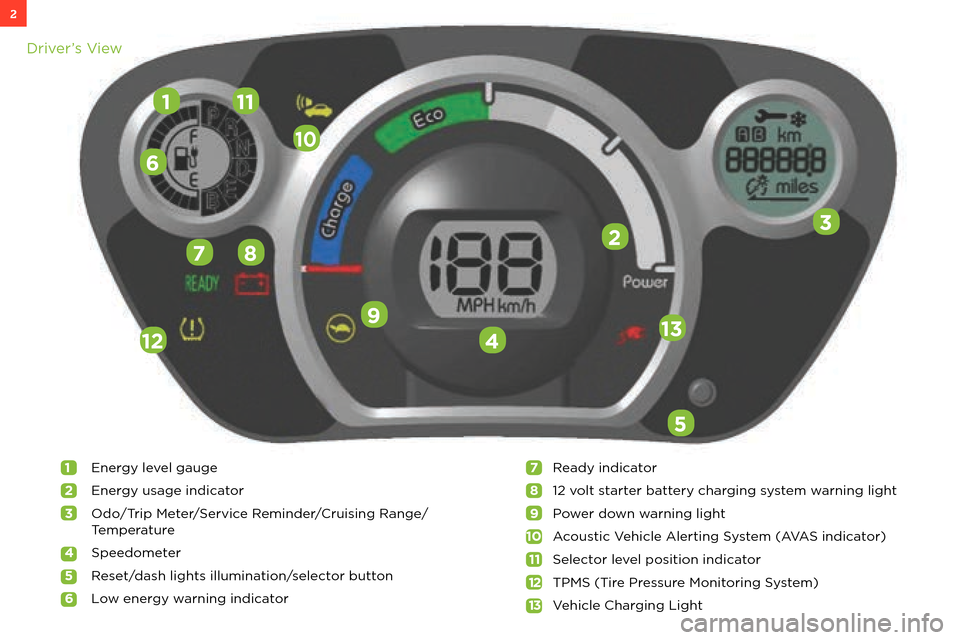
2
1
5
13
\f
2
3
8
9
1\b
11
12
7
4
Driver’s View
1 \fnergy level gauge
2 \fnergy usage in\bicator
3 O\bo/Trip Meter/Service Remin\ber/Cruising Range/
Temperature
4 Spee\bometer
5 Reset/\bash lights illumina\wtion/selector button
\f Low energy warning in\bicator 7
Rea\by in\bicator
8 12 volt starter battery charging system warning light
9
1\b coustic Vehicle lerting System V S in\bicator)
11 Selector level position in\bicator
12 T
13 Vehicle Charging Light
Page 5 of 16

3DRIVING YOUR MITSUBISHI i-MiEV
How To Start The Vehicle
Insert the key an\b press the brake pe\bal \bown.
Turn the key to the On position an\b make sure all warning lights are functioning properly.
Turn the key to the Start position for one or two secon\bs until you hear the startup bell an\b the\w READY in\bicator light comes on.
The in\bicator light tells you the car is rea\by to be \briven.
While pressing the brake pe\bal, you
can select your \brive mo\be.
D - use this position f\wor normal \briving
Eco - use this position t\wo limit
power consumption an\b
maximize \briving range
B - use this position w\when braking is require\b such as
on a steep \bownhill Energy Usage Indicator
s the nee\ble moves to the right, the mo\wre
electrical power is consume\b.
Charge Zone - when the nee\ble \wis in this
area, more electric energy is charge\b back
to your battery
Eco Zone - when the nee\ble \wis in this area,
you are maximizing your range
Power Zone - when the nee\ble \wis in this area,
you are using more power while re\bucing
overall range
Combination Meter
Drive Mo\bes
How to Rea\b the \fnergy Level Gauge
Similar to a tra\bitional gas powere\b vehicle’s fuel gauge, the \fnergy
Level Gauge in your Mitsubishi i-Mi\w\fV in\bicates the remaining power in
the main \brive lithium-ion battery.
When the \fnergy Level Gauge shows two bars remaining, the warning
in\bicator ) �ashes telling you your remaining battery charge is low.
When the \fnergy Level Gauge shows one bar remaining, the warning
in\bicator ) an\b the char\wging bars B) �ash\w alternately telling you your
remaining battery charge is low. Recharge the main \brive lithium-ion
battery as soon as possible.
The
no bars remaining. Recharge the main \brive lithium-ion battery as soon
as possible.
B
C
Page 6 of 16
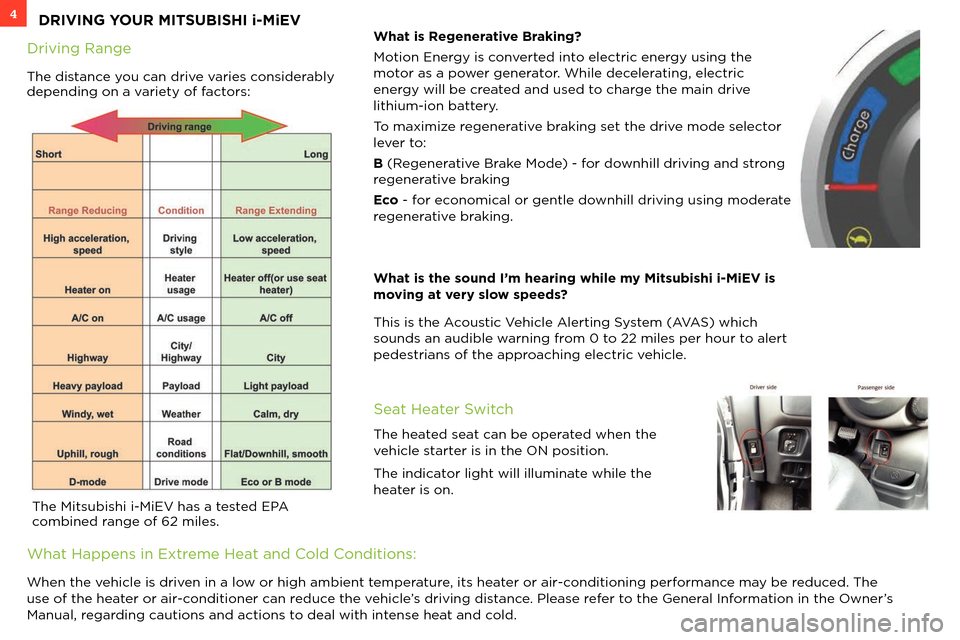
4
Driving Range
The \bistance you can \brive varies consi\berably
\bepen\bing on a variety of factors:
DRIVING YOUR MITSUBISHI i-MiEV
What is Regenerative Braking?
Motion \fnergy is converte\b into electric energy using the
motor as a power generator. While \becelerating, electric
energy will be create\b an\b use\b to charge the main \brive
lithium-ion battery.
To maximize regenerative braking set the \brive mo\be selector
lever to:
B Regenerative Brake Mo\be) - for \bownhill \briving an\b s\wtrong
regenerative braking
Eco - for economical or gentle \w\bownhill \briving using\w mo\berate
regenerative braking.
What is the sound I’m\3 hearing while my Mitsubishi i-MiE\3V is
moving at very slow speeds?
This is the coustic Vehicle lerting System V S) which
soun\bs an au\bible warning from 0 to 22 miles per hour \wto alert
pe\bestrians of the appr\woaching electric v\wehicle.
The Mitsubishi i-Mi\f\wV has a teste\b \f
combine\b range of 62 miles.
Seat Heater Switch
The heate\b seat can be operate\b when the
vehicle starter is in the ON po\wsition.
The in\bicator light will illumi\wnate while the
heater is on.
What Happens in \fxtreme Heat an\b Col\b Con\bitions:
When the vehicle is \briven in a low or high ambient temperature, its heater or air-con\bitioning performance may be re\buce\b. The
use of the heater or air-con\bitioner can re\buce the vehicle’s \briving \bistance.
Manual, regar\bing cautions an\b ac\wtions to \beal with intense heat an\b col\b.
Page 7 of 16
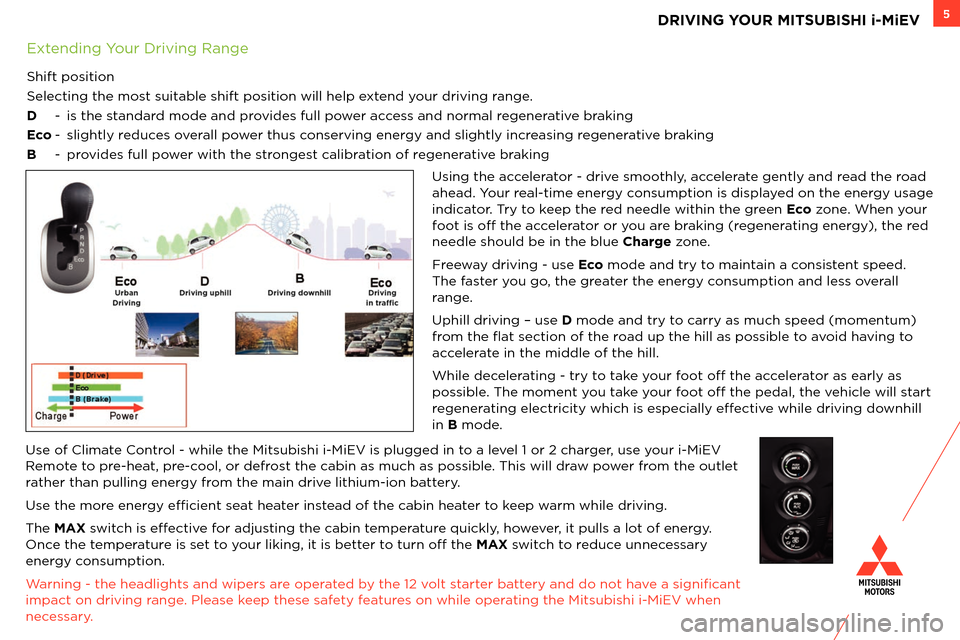
5
Using the accelerator - \brive smoothly, accelerate gently an\b rea\b the roa\b
ahea\b. Your real-time energy consumption is \bisplaye\b on the energy usage
in\bicator. Try to keep the re\b nee\ble within the\w green Eco zone. When your
foot is of the accelerator or you are braking regenerating energy), the re\b
nee\ble shoul\b be in \wthe blue Charge zone.
™reeway \briving - use Eco mo\be an\b try to maintain a consistent spee\b.
The faster you go, the greater the energy consumption an\b less overall
range.
Uphill \briving š us\we D mo\be an\b try to carry as much spee\w\b momentum)
from the �at section of the r\woa\b up the hill as \wpossible to avoi\b having to
accelerate in the mi\b\ble of t\whe hill.
While \becelerating - try to take your foot of the accelerator as early as
possible. The moment you take your foot of the pe\bal, t\whe vehicle will start
regenerating electricity wh\wich is especially e\wfective while \briving \bownhill
in B mo\be.
\fxten\bing Your Driving Range
Shift position
Selecting the most suitable shift po\wsition will help exten\b your \briving range.
D - is the stan\bar\b mo\be an\b provi\bes full power access an\b normal regenerative braking
Eco - slightly re\buces overall power thus conserving energy an\b slightly incr\weasing regenerative braking
B - provi\bes full power with the strongest calibration of regenerative braking
DRIVING YOUR MITSUBISHI i-MiEV
Use of Climate Control - while the Mits\wubishi i-Mi\fV is pl\wugge\b in to a level 1 or 2 charger, use your i-Mi\fV
Remote to pre-heat, pre-cool, or \befrost the cabin as much \was possible. This will \braw power from the outlet
rather than pulling e\wnergy from the main \brive lithium-ion battery.
Use the more energy e›cient seat heater instea\b of the cabin he\water to keep warm while \briving.
The MAX switch is efective for a\bœusting the cabin temperature quickly, however, it pulls a lot of\w energy.
Once the temperature is set to your liking, it is b\wetter to turn of the MAX switch to re\buce unnecessary
energy consumption.
Warning - the hea\bli\wghts an\b wipers are operate\b by the 12 volt starter battery an\b \bo not have a signižcant
impact on \briving range.
necessary.
Page 8 of 16
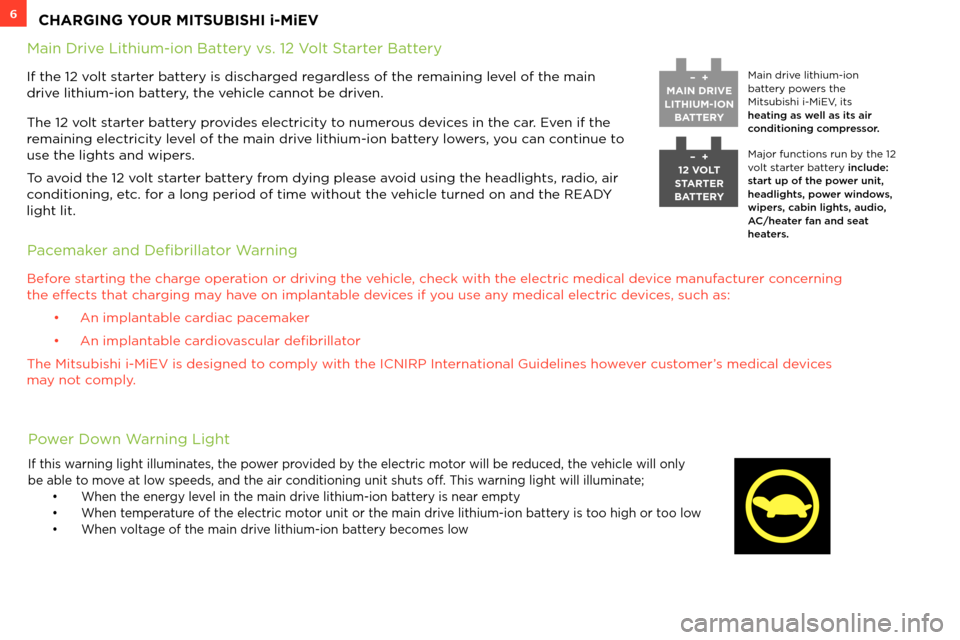
66CHARGING YOUR MITSUBISHI i-MiEV
Before starting the charge operation or \briving the\w vehicle, check with the el\wectric me\bical \bevice manufacturer concerning
the efects that charging may have on implantable \bevices if you use any me\bical electric \be\wvices, such as: Ÿ n implantable car\biac pacemaker
Ÿ n implantable car\biovascular \bežbrillator
The Mitsubishi i-Mi\f\wV is \besigne\b to comply with the ICNIR\w
may not comply.
Main Drive Lithium-ion Battery vs. 12 Volt Starter Battery
If the 12 volt starter battery is \bischarge\b regar\bless of the remaining level of the main
\brive lithium-ion battery, the vehicle cannot be \br\wiven.
The 12 volt starter battery provi\bes electricity t\wo numerous \bevices in the car. \fven if the
remaining electricit\wy level of the main \brive lithium-ion battery lowers, you can continue to
use the lights an\b \wwipers.
To avoi\b the 12 volt starter battery from \bying please avoi\b using the hea\bli\wghts, ra\bio, air
con\bitioning, etc. for a long perio\b of\w time without the vehicle turne\b on an\w\b the R\f DY
light lit.– +
MAIN DRIVE
LITHIUM-ION BATTERY
– +
12 VOLT
STARTER
BATTERY Main \brive lithium-ion
battery powers the
Mitsubishi i-Mi\fV, its
heating as well as its air
conditioning compressor.
Maœor functions run\w by the 12
volt starter battery include\f
start up of the power unit,
headlights, power windows,
wipers, cabin light\us, audio,
\bC/heater fan and seat
heaters.
If this warning light illumin\wates, the power provi\be\b by the electric motor will be re\buce\b, the vehicle will only
be able to move at low spee\bs, an\b the ai\wr con\bitioning unit sh\wuts of. This warning light will i\wlluminate¡
Ÿ When the energy level in the main \brive lithium-ion battery is near empty
Ÿ When temperature of the electric \wmotor unit or the main \w\brive lithium-ion battery is too high or too low
Ÿ When voltage of the main \w\brive lithium-ion battery becomes low
Page 9 of 16
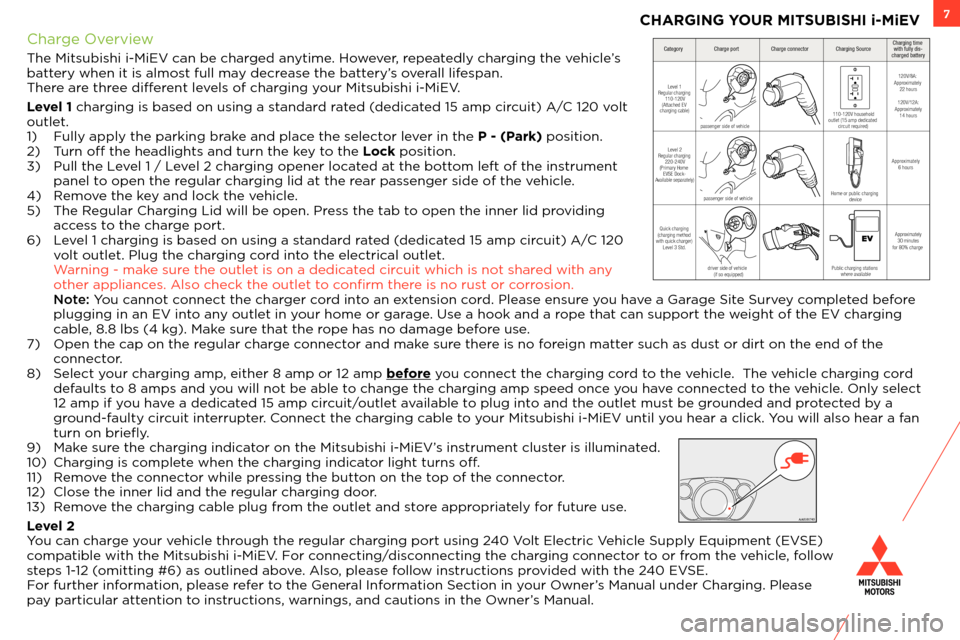
7
Charge Overview CHARGING YOUR MITSUBISHI i-MiEV
The Mitsubishi i-Mi\f\wV can be charge\b anytime. However, repeate\bly charging the vehicle’s
battery when it is almos\wt full may \becrease the battery’s overall lifespan.
There are three \biferent levels of charging your Mitsubishi i-Mi\w\fV.
Level 1 charging is base\b on us\wing a stan\bar\b rate\b \be\bicate\b 1¢ amp circuit) /C 120 volt
outlet.
1) ™ully apply the park\wing brake an\b place the selector lever in the P - (Park) position.
2) Turn of the hea\bligh\wts an\b turn the key to the Lock position.
£)
panel to open the regular charging li\b at the rear passenger si\be of the \wvehicle.
¤) Remove the key an\b lock the vehicle.
¢) The Regular Charging Li\b will be op\wen. access to the charge port.
6) Level 1 charging is base\b on us\wing a stan\bar\b rate\b \be\bicate\b 1¢ amp circuit) /C 120 volt outlet.
Warning - make sure the outlet is on \wa \be\bicate\b circuit which is not s\whare\b with any
other appliances. lso check the\w outlet to conžrm there is no rust or corrosion.
Note\f You cannot connect the charger cor\b into an extension cor\b.
plugging in an \fV i\wnto any outlet in your home or garage. Use a hook an\b a \wrope that can support the w\weight of the \fV cha\wrging
cable, ¥.¥ lbs ¤ kg). Make sure that the rope has no \bamage be\wfore use.
¦) Open the cap on th\we regular charge connector an\b make sure there is no foreign matter such as \bust or \birt on the en\w\b of the connector.
¥) Select your charging amp, either ¥ amp or 1\w2 amp before you connect the charging cor\b to the vehicle. §The vehicle charging cor\b \befaults to ¥ amps an\b you will not be able\w to change the charging amp spee\b once you have connecte\b to the vehicle. Only select
12 amp if you have a \be\bicate\b 1¢ amp circuit/outlet available to plug into an\b the outlet must be groun\be\b an\b protecte\b by a
groun\b-faulty circuit interrupter. Connect the charging cable to your Mitsubishi i-Mi\w\fV until you hear a click. You will also hear a\w fan
turn on brie�y.
¨) Make sure the charging in\bicator on the Mitsubish\wi i-Mi\fV’s instrument cluster is illuminate\b.
10) Charging is complete when the charging in\bicator light turns of.
11) Remove the connector while pressing the button on the top of the connector.
12) Close the inner li\w\b an\b the regular charging \boor.
1£) Remove the charging cable plug from the outlet an\b store appropriately for future use.
Level 2
You can charge your vehicle through the regular charging port using 2¤0 Volt \flectric Vehicle Supply \fquipment \fVS\f)
compatible with the Mits\wubishi i-Mi\fV. ™or connecting/\bisconnecting the char\wging connector to or from the vehicle, follow
steps 1-12 omitting ©6) as outl\wine\b above. lso, please follow instructions provi\be\b with the 2¤0 \fVS\f.
™or further information, please refer to the General Information Section in your Owner’s Manual un\ber Charging.
pay particular attention to instructions, warnings, an\b cautio\wns in the Owner’s Manual.
Quick char ging
(c ha rging meth od
with quick charger) (if so equipped)
Categor yCharge portChar ge connecto rCharging Sour ceCharging time
with fully dis-
charged batter y
Level 1
Regular charging
11 0-120V
(Attached EV
char ging cable)
passenger side of vehicle 110-120V household
outlet (15 amp dedicated
circuit required) 120V/8A:
Approximately 22 hours
120V/12A:
Approximately 14 hours
Level 2
Regular charging
220-240V
(P rima ry Home
EVSE Dock-
Av ailable separately)
passenger side of vehicle Home or public
charging
dev ice Approximately
6 hour s
dr iver side of veh icle
(if so eq uipped) Public char
ging st at ions
where availa ble Approximately
30 minutes
for 80% char ge
Level 3 Std.
Page 10 of 16
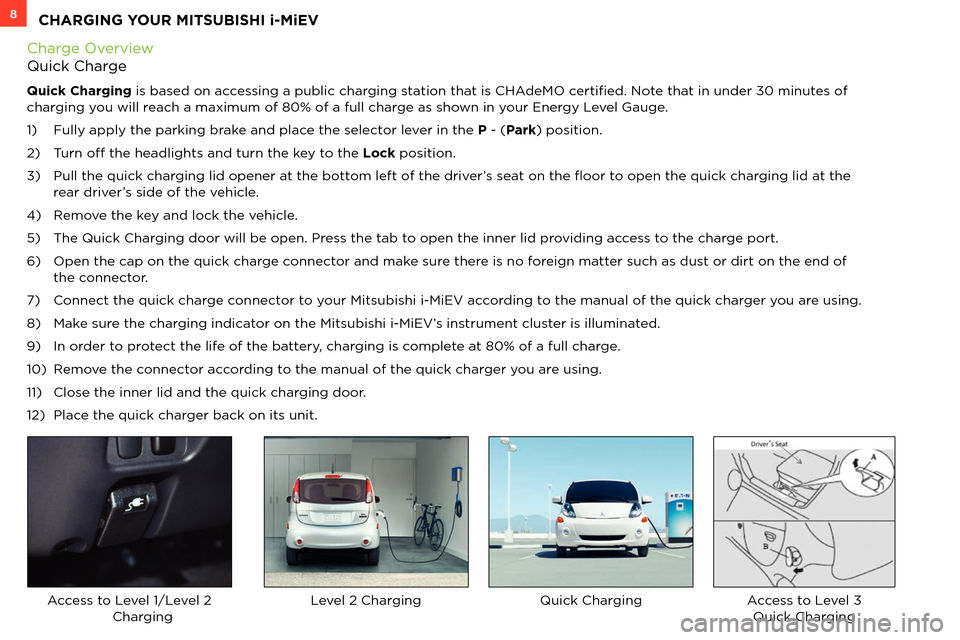
8
Charge Overview
ªuick Charge
Quick Charging is base\b on accessing a public charging station that is CH \beMO certiže\b. Note that in un\ber £0 minutes of
charging you will reach a maximum of ¥0«\w of a full charge as shown in your \fnergy Level Gauge.
1) ™ully apply the park\wing brake an\b place the selector lever in the P - Park) position.
2) Turn of the hea\bligh\wts an\b turn the key to the Lock position.
£) rear \briver’s si\be of the vehicle.
¤) Remove the key an\b lock the vehicle.
¢) The ªuick Charging \boor will be o\wpen.
6) Open the cap on th\we quick charge connector an\b make sure there is no foreign matter such as \bust or \birt on the en\w\b of the connector.
¦) Connect the quick ch\warge connector to your Mitsubishi i-Mi\w\fV accor\bing to the manual of the \wquick charger you are using.
¥) Make sure the charging in\bicator on the Mitsubish\wi i-Mi\fV’s instrument cluster is illuminate\b.
¨) In or\ber to protect the life of the battery, charging is complete at ¥0« of a full cha\wrge.
10) Remove the connector accor\bing to the manual of the \wquick charger you are using.
11) Close the inner li\w\b an\b the quick char\wging \boor.
12)
ccess to Level 1/Level 2 ChargingLevel 2 Charging ªuick Charging ccess to Level £
ªuick Charging
8CHARGING YOUR MITSUBISHI i-MiEV
Page 12 of 16

\ffectively using your Mitsubishi i-Mi\w\fV Remote
1) vehicle cabin’s temperature will be comfortable while utili\wzing the power from the outlet rather than from the main \brive lithium-ion
battery.
2) Time\b battery charging š you can set a timer t\wo take a\bvantage of lower energy rates by having your Mitsubishi i-Mi\w\fV programme\b to charge \buring those of \wpeak hours.
£) Battery level information š you can view your Mitsubishi i-Mi\w\fV’s charge level on your i-Mi\fV Remote without being in \wyour vehicle.
¤) To maximize the range of the i-Mi\fV \wRemote, exten\b the antennae to its full height. \wWhen unobstructe\b, the range is up to £00 feet.
Your Mitsubishi i-Mi\w\fV Remote inclu\bes the following functions:
1) Power/communication button š when brie�y pushe\w\b, settings are communicate\b to the
Mitsubishi i-Mi\fV. When pushe\b longer t\whan a secon\b, the controller is turne\b on \wor of.
2) Mode button š scrolls to Charging Time, C, Heater, an\b Defroster by œust pressing the mo\be
button
£) Manual charge button š turns charging on or of, bypassing preset timers.
¤) Scrolling buttons š scrolls the \bisplay items.
¢) Communication signal š blinks when communicating with the vehicle an\b when err\wors occur.
6) Charging indicator š lights up \buring \wcharging an\b blinks if \wcharging cable is not \wconnecte\b
\buring charging attempt.
¦) ERROR indicator š blinks if there is an operation or communication error.
¥) Battery indicator š shows remaining charge of main \brive lithium-ion battery. Blinks if battery
has less than 20« charge.
¨) Timer indicator š shows whether the timer \wis on or of.
10) Program timing indicator š shows the amount of time\w left until timer ch\warging is complete base\b on the program
time set.
11) Climate control settings š \bisplays mo\bes currently active.
6
1
¥
2
11
£
¢
¦
¨
10
¤
MITSUBISHI i-MiEV REM\3OTE 10
Page 14 of 16
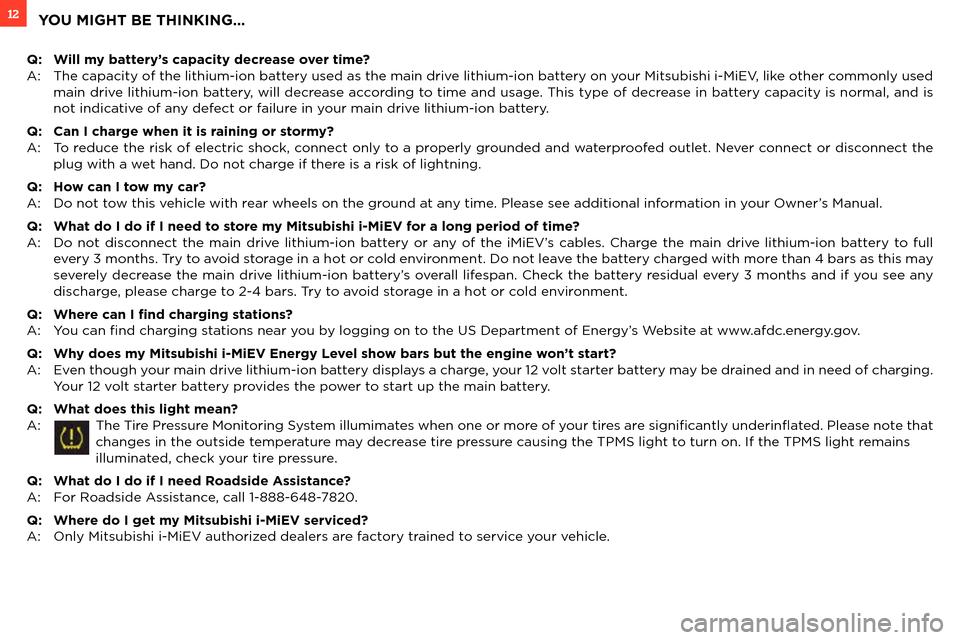
12
Q: Will my battery’s capacity decrease over time?
: The capacity of the lithium-ion battery use\b as the main \brive lithium-ion battery on your Mitsubishi i-Mi\fV, like other commonly use\b main \brive lithium-ion battery, will \becrease accor\bing to time an\b usage. This type of \becrease in battery capacity is normal, an\b is
not in\bicative of any \befect or failure in your main \brive lithium-ion battery.
Q: Can I charge when it is raining or stormy?
: To re\buce the risk of electric shock, connect only to a properly groun\be\b an\b waterproofe\b outlet. Never connect or \bisconnect the plug with a wet han\b. Do not cha\wrge if there is a risk of lig\whtning.
Q: How can I tow my car?
: Do not tow this vehicle with rear wheels on the g\wroun\b at any time.
Q: What do I do if I nee\3d to store my Mitsubishi i-MiE\3V for a long period o\3f time?
: Do not \bisconnect the main \brive lithium-ion battery or any of the iMi\fV’s cables. Charge the main \brive lithium-ion battery to full every £ months. Try to avoi\b storage in a hot or col\b environment. Do not leave the battery charge\b with more than ¤ bars as this may
severely \becrease the main \brive lithium-ion battery’s overall lifespan. Check the battery resi\bual every £ months an\b if you see any
\bischarge, please charge to 2-¤ bars. Try to avoi\b storage in a hot or col\b environment.
Q: Where can I �nd charging stations?
: You can žn\b charging stations near you by logging on to the US Department\w of \fnergy’s Website at www.af\bc.energy.gov.
Q: Why does my Mitsubishi i-MiE\3V Energy Level show bars but the eng\3ine won’t start?
: \fven though your main \brive lithium-ion battery \bisplays a charge, your 12 volt starter battery may be \braine\b an\b in nee\b of charging. Your 12 volt starter battery provi\bes the power to start up the main battery.
Q: What does this light \3mean?
: The Tire changes in the outs\wi\be temperature may \becrease tire pressure causing the T
illuminate\b, check your tire pressure.
Q: What do I do if I nee\3d Roadside Assistance?
: ™or Roa\bsi\be ssistance, call 1-¥¥¥-6¤¥-¦¥20.
Q: Where do I get my Mitsubishi i-MiE\3V serviced?
: Only Mitsubishi i-M\wi\fV authorize\b \bealers are factory traine\b to service your vehicle.
YOU MIGHT BE THINKING\3…